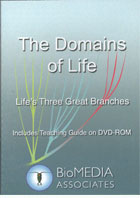
The Domains of Life: Life's Three Great Branches 2006
Distributed by BioMEDIA Associates, PO Box 1234, Beaufort, SC 29901-1234; 877-661-5355
Produced by BioMEDIA ASSOCIATES
Director n/a
DVD, color, 35 min.
Sr. High - College
Biology, Chemistry, Evolution, Science
Date Entered: 02/23/2007
Reviewed by Carrie M. Macfarlane, Reference and Instruction Librarian for the Sciences, Middlebury College, Middlebury, VTThe Domains of Life defines the relatively new classification system that divides living organisms into three domains and examines the evolution of eukaryotic cells. Certainly there are free web sites that explain this theory, but the videos, quizzes, and guides on this DVD are effectively integrated and can help direct learning to an extent that would be difficult to accomplish through any single medium.
While the Three Domains theory is now well-established in the scientific community, some textbooks have not kept pace with the research that supports it. The teaching guide therefore offers a useful overview of the development of the theory, including a table comparing the three domains to the former five-kingdom system. The teaching guide also includes curriculum suggestions, quizzes, and answer keys.
The guide for students is both voluminous and substantive, including a visual reference tool that provides a quick outline of the video's topics. Links to external sources point viewers to opportunities for further enrichment. For example, a description of the evolution of early life links to an interview with a scientist who created the first simulation of the chemical conditions found on prehistoric Earth.
Despite a balanced overview of each of the domains, it is Eucarya that dominates most of the nine units on this DVD. Interestingly, the table of contents for the study guide groups the units into two parts, one for the introduction to the domains and the other for Eucarya. The scope of the DVD would be quicker to grasp if the table of contents for the DVD did the same.
Still, the videos and microphotography make for a lively introduction to the material, and the explanations are easy to follow. As the narrative guides us through the major events in the evolution of eukaryotes, it reminds us of the centrality of natural selection to the process. Why did multi-cellular organisms come to be? The narrator suggests that the answer may be their relative size: the bigger something grows, the harder it is for a predator to swallow.
Because much of the content is devoted to eukaryote evolution, several key cellular functions are covered in detail. For example, in the unit, "Motor Proteins Get Cells Moving," the interaction between actin and myosin is described precisely through colorful animation. The video presents animations throughout that provide clear demonstration of the processes described.
The Domains of Life is dense with useful and current educational content. It is recommended for advanced high school science classes, and it could easily be used as self-paced review material for introductory biology courses at the collegiate level too.